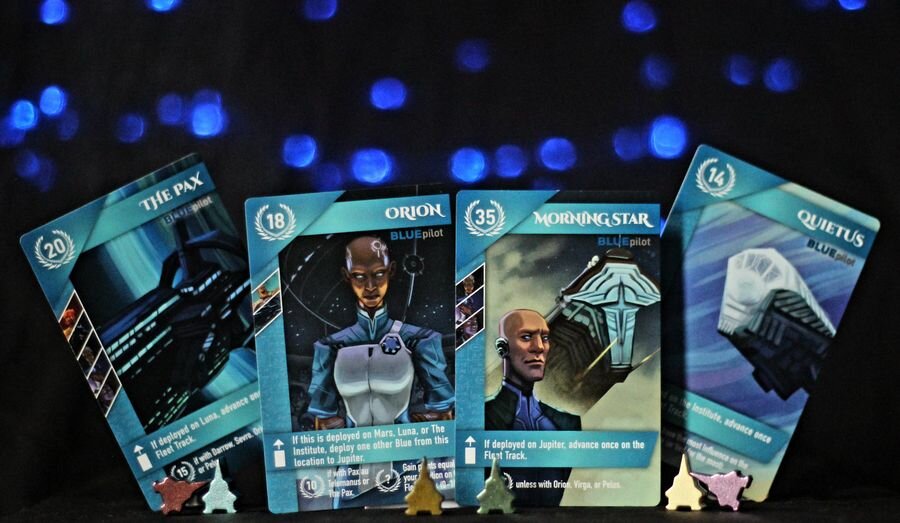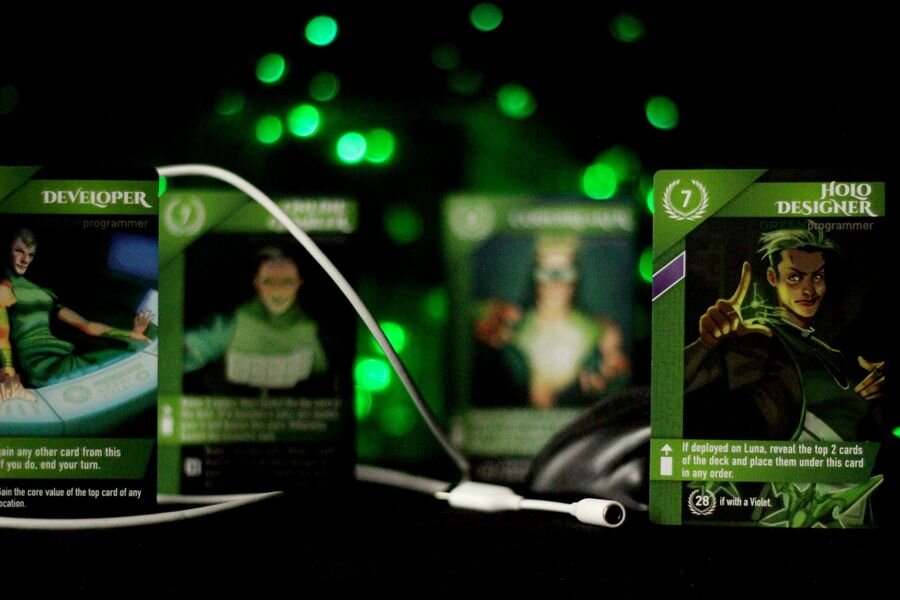Red Rising – First Impressions
Review copy provided by the publisher
Red Rising is one of my favorite book series in recent memory. It’s a superlative exploration of a social caste system, dystopian strife, and futuristic warfare. Pierce Brown, the author, has really matured over the course of the five books—part of two distinct trilogies—and I can’t wait to see how he concludes the saga in the next title.
Apparently, Jamey Stegmaier is just as much of a fan (probably more) because he’s been working for years now to develop a board game adaptation of the series. And he’s finally achieved his goal with Red Rising, a hand-management card game based in the universe of the book series and centered around the ideas of class warfare, rebellion, and breaking the chains!
In this combo-building game, one to six players will engage in a tight economy of cards. Players will either Lead—deploying cards from their hand, activating an ability, and then retrieving a different card from the board—or Scout—taking a new card off of the deck and placing it down on the location. Both actions give small benefits but Leading shifts the composition of your hand to enable better combos and Scouting brings new cards into play and helps to block other cards or change the state of the board’s four locations.
Whoever has the highest score at the end wins! And since I’m getting to jump back into the world of Red Rising while playing a board game, then I win no matter what…
What It Does
Photo credits: All About Games photography via @gralutka on Instagram
In the world of Red Rising, everyone is divided into fourteen different color castes. The stratification is a suppressive foundation for the dominance of the Golds, who rule with an iron grip. In the oppressive societal pyramid, there are three tiers— HighColors, MidColors, and LowColors. Within those layers are the Golds, Silvers, Whites, and Coppers; the Blues, Yellows, Greens, Violets, Oranges, and Grays; and then the Browns, Obisidians, Pinks, and Reds.
Players of the board game will see all of these Colors represented and each of them features variable core values in points as well as unique deployment abilities that trigger when placed on the board, endgame abilities, and additional scoring potential based on what combos a player has created.
The game is quite simple. Within an hour, players will prune their hand, add to it judiciously, and slowly create a winning combination of Colors and characters who maximize the scoring potential.
You could focus on acquiring Golds at all costs, relying on their sturdy core point value. Or you could build an insurrectionist deck of LowColors that work together to overwhelm higher Colors. But then again, maybe a mix of those two strategies will be the best. It’s up to you to figure that out because players will likely not exhaust the 112 character cards in the deck. The best combinations won’t necessarily be the easiest ones to see.
Outside of your hand of cards, you will also be racing against players on several victory tracks, which are what triggers the endgame and provides other avenues for scoring. The Fleet track, the Institute, and player reserves of Helium are all valuable in the game and will contribute to a player’s winning strategy.
How It Does It
Each Color has a different style of “attack” or intrigue. That should be considered when building your hand. Reds—the manual laborers and LowColor workers—benefit from other LowColors and typically work to build a ready supply of Helium or combine to attack HighColors like the ruling Golds. Blues are the conductors of the space fleets and include the ships themselves. Greens manipulate other cards and the state of things with their digital savvy. Golds dominate with wanton destruction or careful excision, with very few that “play nice” with the other Colors.
It will be up to the players to figure out how best to allocate their deployment abilities to grow their hands and increase the efficacy of their combos. Knowing when to Lead and when to Scout is an important skill in Red Rising.
There are benefits to pushing deeply into one or two Colors, but you can also get strong combinations by seeking out cards from all over the caste pyramid. It’s dependent on the cards in play and the whims of the other players who might interfere with your strategy.
And be mindful of the other point tracks and endgame conditions as they can be powerful additives to your scoring soup. High progress on the Fleet track can grant players 30 or 40 points. Same with an abundant supply of Helium or a top position within the Institute.
Beyond the cards that you play, the ones you keep, and the characters who you may banish along the way, it’s also valuable to understand which House you’re playing as and how they can be exploited for gain. Each player assumes control of one of the powerful Gold houses and each one provides a bonus ability which is activated whenever the Sovereign token is taken.
The Sovereign token is the fourth location bonus beyond advancement on the Fleet track, additional receipt of Helium, or larger presence in the Institute. And that token activates the ability of whatever House claims it. That bonus ability is another tactical advantage to consider, especially since it also gives some points at the end of the game.
Why You Might Like It
Red Rising accurately presents the conflict between the Colors by creating a shifting tide of alliances, betrayals, and murky ceasefires between character cards in a player’s hand. Take the Reds and the other LowColors to new heights or keep them oppressed under the thumb of the Golds. It’s your choice.
Besides the thematic achievement, the game creates an engaging hand-management experience in a short amount of time. Games will take less than 60 minutes, and could definitely steer toward 30-40 minutes once players know the cards well.
Why You Might Not
While you may still enjoy that game despite not knowing anything about the book series, the strong visual and thematic connection to its source material might leave some players lost at sea when playing.
Despite high replay value from the big deck of cards and the potential combos, it’s a light game that strays away from the weightier content of other Stonemaier titles like Scythe or Tapestry.
Final Thoughts
After two plays—one with four players and one with three—I’m definitely interested to see how this fares after half a dozen more sessions. I want to see how it is with two players. I want to explore more of the deck. In each game, we’ve only made it through about half of the more than 100 cards.
The production quality is fantastic. I got the Collector’s Edition, and though it’s not necessary, it’s a very appealing design. The metal cubes, gold-foil cards, and other premium components all give it a nice heft and table presence.
For someone who cherishes the book series, it’s a real treat to play a game based on the characters who I love and the story that I enjoy so immensely. I think that plenty of players can appreciate and love the board game without any knowledge of the books, but it does make it even better knowing the context of these characters and their motives.
I imagine I’ll be discovering combinations in this game for quite some time. I took two different approaches in the first and second games, so I’m curious to see what I’ll do next. I anticipate high replayability in that regard as players discover new ways to manipulate the Colors and their powers.
I’m not sure if it will play as well with five or six players. Four felt good and will likely be better when the players know the cards better, but I suspect that having more than four will slow the game down too much.
I want to keep playing, which is always a good sign, and I think it will stay on the “ready shelf” in my dining room for a little bit. Bravo to Jamey for sticking with it through multiple designs. And the artists have done a wonderful job in giving life to characters who have only been in my head until now.
Definitely try out the game and see if it’s for you. I think it will be one of my staple “lighter” games for quite some time.
If you want to check out Red Rising, you can visit Stonemaier Games or read what the community thinks on BoardGameGeek.
Have you played Red Rising? What about other combo-heavy hand-building games?
Let us know in the comments and give a recommendation for other games of which to share our first impressions.







